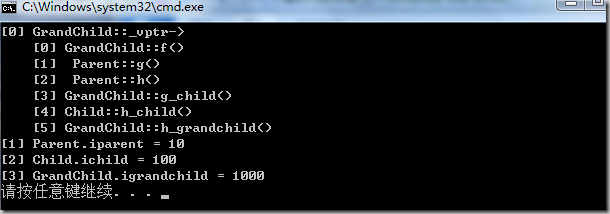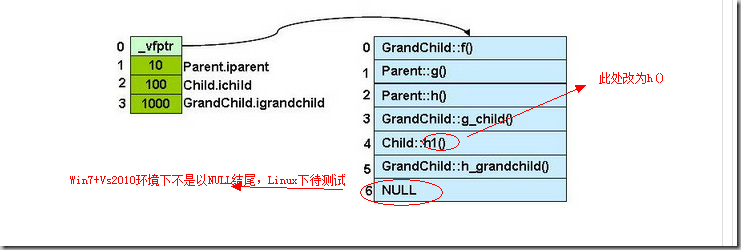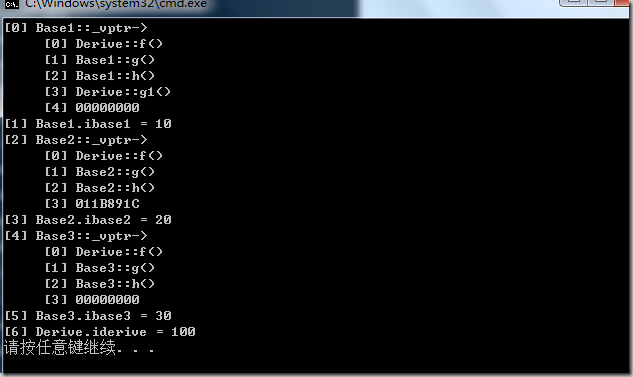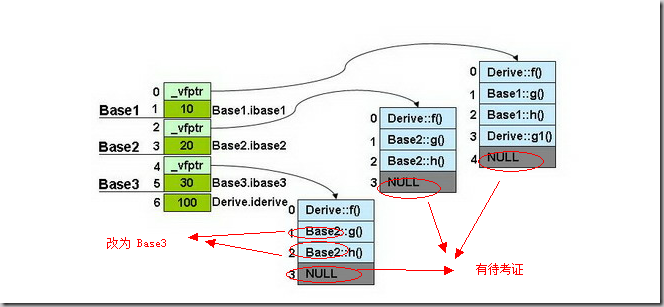对象的影响因素
简而言之,我们一个类可能会有如下的影响因素:
1)成员变量
2)虚函数(产生虚函数表)
3)单一继承(只继承于一个类)
4)多重继承(继承多个类)
5)重复继承(继承的多个父类中其父类有相同的超类)
6)虚拟继承(使用virtual方式继承,为了保证继承后父类的内存布局只会存在一份)
上述的东西通常是C++这门语言在语义方面对对象内部的影响因素,当然,还会有编译器的影响(比如优化),还有字节对齐的影响。在这里我们都不讨论,我们只讨论C++语言上的影响。
本篇文章着重讨论下述几个情况下的C++对象的内存布局情况。
1)单一的一般继承(带成员变量、虚函数、虚函数覆盖)
2)单一的虚拟继承(带成员变量、虚函数、虚函数覆盖)
3)多重继承(带成员变量、虚函数、虚函数覆盖)
4)重复多重继承(带成员变量、虚函数、虚函数覆盖)
5)钻石型的虚拟多重继承(带成员变量、虚函数、虚函数覆盖)
我们的目标就是,让事情越来越复杂。
知识复习
我们简单地复习一下,我们可以通过对象的地址来取得虚函数表的地址,如:
typedef void(*Fun)(void);
Base b;
Fun pFun = NULL;
cout << "虚函数表地址:" << (int*)(&b) << endl;
cout << "虚函数表 — 第一个函数地址:" << (int*)*(int*)(&b) << endl;
// Invoke the first virtual function
pFun = (Fun)*((int*)*(int*)(&b));
pFun();
我们同样可以用这种方式来取得整个对象实例的内存布局。因为这些东西在内存中都是连续分布的,我们只需要使用适当的地址偏移量,我们就可以获得整个内存对象的布局。
本篇文章中的例程或内存布局主要使用如下编译器和系统:
1)Windows 7 和 VC++ 2010
2)Cygwin 和 G++ 3.4.4
单一的一般继承
下面,我们假设有如下所示的一个继承关系:

请注意,在这个继承关系中,父类,子类,孙子类都有自己的一个成员变量。而了类覆盖了父类的f()方法,孙子类覆盖了子类的g_child()及其超类的f()。
我们的源程序如下所示:
#include <iostream>
using namespace std;
class Parent {
public:
int iparent;
Parent ():iparent (10) {}
virtual void f() { cout << " Parent::f()" << endl; }
virtual void g() { cout << " Parent::g()" << endl; }
virtual void h() { cout << " Parent::h()" << endl; }
};
class Child : public Parent {
public:
int ichild;
Child():ichild(100) {}
virtual void f() { cout << "Child::f()" << endl; }
virtual void g_child() { cout << "Child::g_child()" << endl; }
virtual void h_child() { cout << "Child::h_child()" << endl; }
};
class GrandChild : public Child{
public:
int igrandchild;
GrandChild():igrandchild(1000) {}
virtual void f() { cout << "GrandChild::f()" << endl; }
virtual void g_child() { cout << "GrandChild::g_child()" << endl; }
virtual void h_grandchild() { cout << "GrandChild::h_grandchild()" << endl; }
};
int _tmain(int argc, _TCHAR* argv[])
{
typedef void(*Fun)(void);
GrandChild gc;
Fun pFun=NULL;
int** pVtab = (int**)&gc;
cout << "[0] GrandChild::_vptr->" << endl;
/*for (int i=0; (Fun)pVtab[0][i]!=NULL; ++i){*/
//本人注释 测试环境win7+VS2010 经过调试发现此环境下虚函数并不是以NULL结尾,所以原文修改为如下:
for (int i=0; i<6; ++i){
pFun = (Fun)pVtab[0][i];
cout << " ["<<i<<"] ";
pFun();
}
cout << "[1] Parent.iparent = " << (int)pVtab[1] << endl;
cout << "[2] Child.ichild = " << (int)pVtab[2] << endl;
cout << "[3] GrandChild.igrandchild = " << (int)pVtab[3] << endl;
return 0;
}
使用图片表示如下:(红色部分为本人修改)
可见以下几个方面:
1)虚函数表在最前面的位置。
2)成员变量根据其继承和声明顺序依次放在后面。
3)在单一的继承中,被overwrite的虚函数在虚函数表中得到了更新。
多重继承
下面,再让我们来看看多重继承中的情况,假设有下面这样一个类的继承关系。注意:子类只overwrite了父类的f()函数,而还有一个是自己的函数(我们这样做的目的是为了用g1()作为一个标记来标明子类的虚函数表)。而且每个类中都有一个自己的成员变量:

我们的类继承的源代码如下所示:父类的成员初始为10,20,30,子类的为100
#include <iostream>
using namespace std;
class Base1 {
public:
int ibase1;
Base1():ibase1(10) {}
virtual void f() { cout << "Base1::f()" << endl; }
virtual void g() { cout << "Base1::g()" << endl; }
virtual void h() { cout << "Base1::h()" << endl; }
};
class Base2 {
public:
int ibase2;
Base2():ibase2(20) {}
virtual void f() { cout << "Base2::f()" << endl; }
virtual void g() { cout << "Base2::g()" << endl; }
virtual void h() { cout << "Base2::h()" << endl; }
};
class Base3 {
public:
int ibase3;
Base3():ibase3(30) {}
virtual void f() { cout << "Base3::f()" << endl; }
virtual void g() { cout << "Base3::g()" << endl; }
virtual void h() { cout << "Base3::h()" << endl; }
};
class Derive : public Base1, public Base2, public Base3 {
public:
int iderive;
Derive():iderive(100) {}
virtual void f() { cout << "Derive::f()" << endl; }
virtual void g1() { cout << "Derive::g1()" << endl; }
};
int _tmain(int argc, _TCHAR* argv[])
{
typedef void(*Fun)(void);
Derive d;
Fun pFun=NULL;
int** pVtab = (int**)&d;
cout << "[0] Base1::_vptr->" << endl;
pFun = (Fun)pVtab[0][0];
cout << " [0] ";
pFun();
pFun = (Fun)pVtab[0][1];
cout << " [1] ";pFun();
pFun = (Fun)pVtab[0][2];
cout << " [2] ";pFun();
pFun = (Fun)pVtab[0][3];
cout << " [3] "; pFun();
pFun = (Fun)pVtab[0][4];
cout << " [4] "; cout<<pFun<<endl;
cout << "[1] Base1.ibase1 = " << (int)pVtab[1] << endl;
int s = sizeof(Base1)/4;
cout << "[" << s << "] Base2::_vptr->"<<endl;
pFun = (Fun)pVtab[s][0];
cout << " [0] "; pFun();
pFun = (Fun)pVtab[s][1];
cout << " [1] "; pFun();
pFun = (Fun)pVtab[s][2];
cout << " [2] "; pFun();
pFun = (Fun)pVtab[s][3];
cout << " [3] ";
cout<<pFun<<endl;
cout << "["<< s+1 <<"] Base2.ibase2 = " << (int)pVtab[s+1] << endl;
s = s + sizeof(Base2)/4;
cout << "[" << s << "] Base3::_vptr->"<<endl;
pFun = (Fun)pVtab[s][0];
cout << " [0] "; pFun();
pFun = (Fun)pVtab[s][1];
cout << " [1] "; pFun();
pFun = (Fun)pVtab[s][2];
cout << " [2] "; pFun();
pFun = (Fun)pVtab[s][3];
cout << " [3] ";
cout<<pFun<<endl;
s++;
cout << "["<< s <<"] Base3.ibase3 = " << (int)pVtab[s] << endl;
s++;
cout << "["<< s <<"] Derive.iderive = " << (int)pVtab[s] << endl;
return 0;
}
我们通过上面的程序来查看子类实例的内存布局:上面程序中,注意我使用了一个s变量,其中用到了sizof(Base)来找下一个类的偏移量。(因为我声明的是int成员,所以是4个字节,所以没有对齐问题。关于内存的对齐问题,大家可以自行试验,我在这里就不多说了)
使用图片表示是下面这个样子:
我们可以看到:
1) 每个父类都有自己的虚表。
2) 子类的成员函数被放到了第一个父类的表中。
3) 内存布局中,其父类布局依次按声明顺序排列。
4) 每个父类的虚表中的f()函数都被overwrite成了子类的f()。这样做就是为了解决不同的父类类型的指针指向同一个子类实例,而能够调用到实际的函数。








